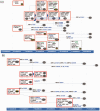Genomic analysis of SARS-CoV-2 reveals local viral evolution in Ghana
- PMID: 33325750
- PMCID: PMC7746953
- DOI: 10.1177/1535370220975351
Genomic analysis of SARS-CoV-2 reveals local viral evolution in Ghana
Abstract
The confirmed case fatality rate for the coronavirus disease 2019 (COVID-19) in Ghana has dropped from a peak of 2% in March to be consistently below 1% since May 2020. Globally, case fatality rates have been linked to the strains/clades of circulating severe acute respiratory syndrome coronavirus 2 (SARS-CoV-2) within a specific country. Here we present 46 whole genomes of SARS-CoV-2 circulating in Ghana, from two separate sequencing batches: 15 isolates from the early epidemic (March 12-April 1 2020) and 31 from later time-points ( 25-27 May 2020). Sequencing was carried out on an Illumina MiSeq system following an amplicon-based enrichment for SARS-CoV-2 cDNA. After genome assembly and quality control processes, phylogenetic analysis showed that the first batch of 15 genomes clustered into five clades: 19A, 19B, 20A, 20B, and 20C, whereas the second batch of 31 genomes clustered to only three clades 19B, 20A, and 20B. The imported cases (6/46) mapped to circulating viruses in their countries of origin, namely, India, Hungary, Norway, the United Kingdom, and the United States of America. All genomes mapped to the original Wuhan strain with high similarity (99.5-99.8%). All imported strains mapped to the European superclade A, whereas 5/9 locally infected individuals harbored the B4 clade, from the East Asian superclade B. Ghana appears to have 19B and 20B as the two largest circulating clades based on our sequence analyses. In line with global reports, the D614G linked viruses seem to be predominating. Comparison of Ghanaian SARS-CoV-2 genomes with global genomes indicates that Ghanaian strains have not diverged significantly from circulating strains commonly imported into Africa. The low level of diversity in our genomes may indicate lower levels of transmission, even for D614G viruses, which is consistent with the relatively low levels of infection reported in Ghana.
Keywords: COVID-19; SARS-CoV-2; evolution; genomics; novel coronavirus.
Conflict of interest statement
Figures







References
-
- Li Q, Guan X, Wu P, Wang X, Zhou L, Tong Y, Ren R, Leung KSM, Lau EHY, Wong JY, Xing X, Xiang N, Wu Y, Li C, Chen Q, Li D, Liu T, Zhao J, Liu M, Tu W, Chen C, Jin L, Yang R, Wang Q, Zhou S, Wang R, Liu H, Luo Y, Liu Y, Shao G, Li H, Tao Z, Yang Y, Deng Z, Liu B, Ma Z, Zhang Y, Shi G, Lam TTY, Wu JT, Gao GF, Cowling BJ, Yang B, Leung GM, Feng Z. Early transmission dynamics in Wuhan, China, of novel coronavirus-infected pneumonia. N Engl J Med 2020; 382:1199–207 - PMC - PubMed
-
- WHO : coronavirus disease (COVID-19): global epidemiological situation as of 20 September 2020; Geneva, Switzerland: World Health Organization, 2020.
-
- Lurie N, Saville M, Hatchett R, Halton J. Developing covid-19 vaccines at pandemic speed. N Engl J Med 2020; 382:1969–73 - PubMed
Publication types
MeSH terms
Grants and funding
LinkOut - more resources
Full Text Sources
Miscellaneous

